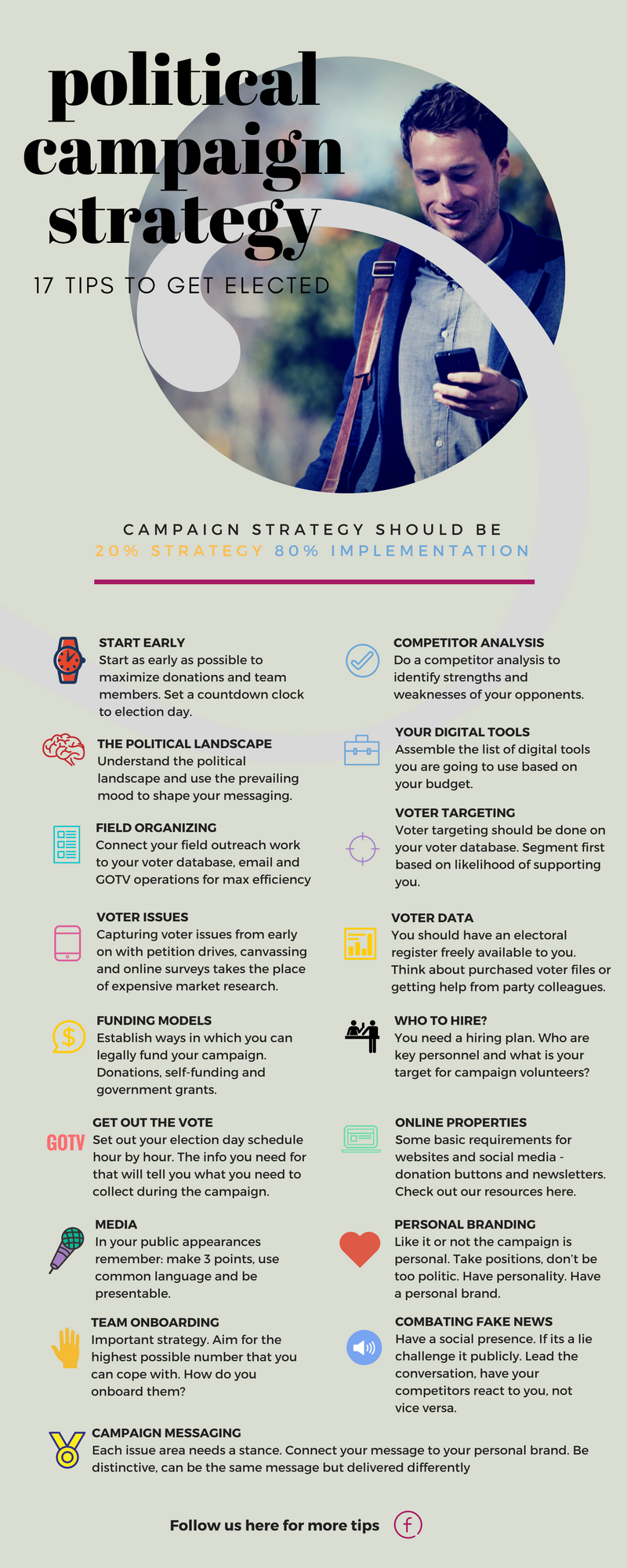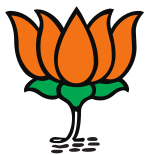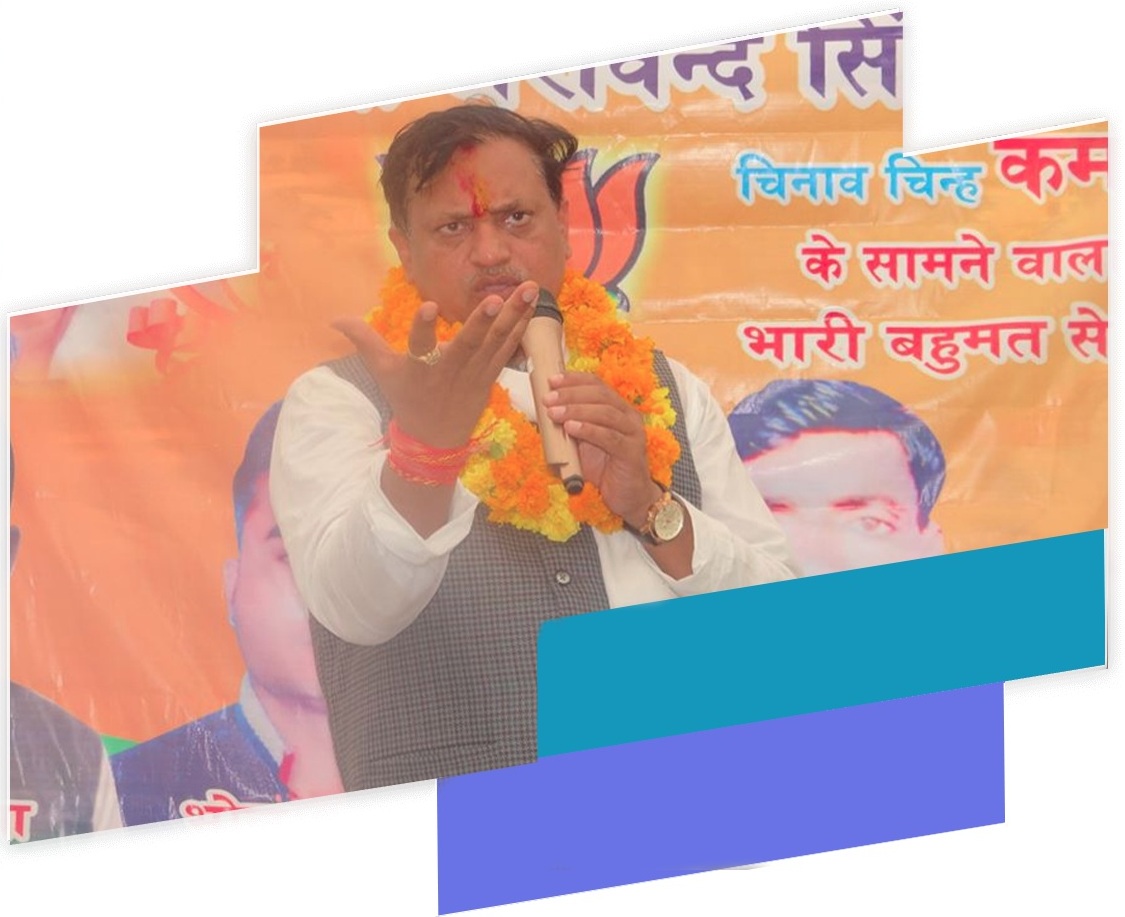Ranneeti Action for Campaign
The point is well made that political campaign strategy should be 20% devising and 80% implementation. That said, as you set out on your campaign, it is a great time to do a lot of that 20% devising.

Starting your campaign
In short, the earlier the better. The best politicians are always campaigning (if only in their own heads), by building relationships, figuring out their future campaign stance based on what they hear, and so on. However, if we are talking about your upcoming election then we will want to start assembling your team and figuring out your campaign strategy as early as is allowable. All of your campaign elements like donations, number of campaign team members, voters contacted, etc, will benefit from having a longer lead time.
Action tip: Set a countdown clock to election day that reminds you of how long you have left to convince your electorate. Here’s one for your laptop.
Competitor analysis
Competitor analysis is essential in any contest. A good understanding of the strengths and weaknesses of your opponents can give you a huge advantage in building your campaign messaging, in head-to-head debates, and in undermining their campaign message when necessary.
Action tip: Develop your competitor analysis worksheet to capture where you stand in relation to other candidates in the race.On a spreadsheet list strengths and weaknesses for all candidates including yourself. On the same spreadsheet itemize each candidates position on the key topics in the election. In this way you will clarify where you are strong, where you are vulnerable and be clear about your messaging in relation to your competitors.
Understanding the political landscape
Before any strategy is put to paper it is worthwhile really considering the political landscape that the election will be fought in. Is it a time of reactionary politics where liberal ideas will not be well received? Are the demographics of the area changing, bringing in a more urban or progressive cohort that might resist conservative ideas? Is there a particular hot-button topic like immigration that is dominating the political discourse? Are you an incumbent politician who is tainted by something that has happened or had to happen during your administration? Will you need to go on the offensive against your competitors for this reason, or will you be fighting a defensive campaign?
If you can understand what voters generally think and you understand the way in which media narratives dictate or undermine what voters think then you have a much better base from which to develop your strategy.
Digital tools
There are a variety of digital tools your campaign will benefit from. They are usually based around giving your team a better shape and organization, or they are designed to improve your ability to communicate. We have put together a fairly detailed list of the top tools that we hear campaigns using here.
Action tip: Set your monthly budget for digital tools and check what you can afford based on our list or from your own digital wish-list.<
Field organizing
For most campaigns, field campaigning is a must. Whether this is done door-to-door or through ‘hot-spot canvassing’ in the community, it is proven to be an effective form of voter persuasion and GOTV strategy. Field organizing strategy needs to be built by someone who has some experience with voter targeting, canvassing techniques, and the tools that facilitate this. At a minimum, you will want to get a return on the investment of time and money into fieldwork translated into votes.
Action tip: If all of this is new to you check out our extensive resources on fieldwork here. If this feels like something you need to hand over to someone more experienced then you should definitely bring someone into your team who has done this before.
Getting voter data
Acquiring voter data for your data should be straightforward but often is not. There are a number of places that you can begin your search. Your local authority should be able to provide you with a digital version of the electoral register. If not, ask them why not? You might be able to get a file from party sources (if you are a political party member) that has been worked on over time. Otherwise, you might be able to purchase a voter file from a third party vendor (if this is legal in your jurisdiction). Failing all of these, a property register can suffice for getting started in building a voter database.
Action tip: Check out our resource on how to acquire a voter database here, or contact us directly and we will see if we can help you based on our knowledge of your area.
Voter targeting
Quick question, do you know how many voters there are in your district? Do you know how many are likely to vote, or who are likely to vote for your competitor? Having answers to these questions will really help you to begin your voter targeting work from the voter databases you have assembled. No campaign expects to communicate with everyone in their district. Ideally, you will just speak to those people who are likely to vote and who are either your supporters or could be convinced to vote for you. If that group of people isn’t big enough to get you elected then you should consider pulling out of the race!
Action tip: Check your voter file for any indications of propensity to vote and previous voting history or support level for your candidacy. If you don’t have this, you are likely to waste a lot of time in your campaign learning about your electorate rather than persuading them.
Capturing voter issues
Everyone running for office has a ‘sense’ of what the electorate think, and they usually try to respond to that understanding of voter issues with campaign messaging in order to represent those views. All of this is great, but in a digital era, it is possible to be a bit more rigorous about this and to capture voter issues in a way that accurately reflects those concerns and helps the campaign team. There are a number of ways this can be done, like online surveys, face-to-face canvassing, market research and social media interaction. The critical thing is to have a codified way of capturing raw data into tags or hashtags for example. Having a way of tagging conversations with #education or #guncontrol will give your team a way to understand the entirety of voter outreach in a simplified way.
Action tip: Set up your campaign tools to capture #issues, for example Ranneeti or NationBuilder have this functionality inbuilt. At the very least you should have a spreadsheet with pre-populated tags where your campaign team can record voter issues.
Funding models
Ok, so assuming you don’t want to remortgage your house to gamble on an election run you will need some strategy for getting money in to pay for you campaign. The smartest bit of research you can do is to copy what similar campaigns do in your district. This will help you to avoid breaking any funding rules while using tried and tested methods of generating revenue. Fundraising events, party stipends, and donations buttons on your website are all common ways to raise money.
Action tip: Set up your core campaign budget based on your lowest projections for donations/funding. Anything you raise above this figure you can channel into scalable campaign spend like digital ads, billboards, paid canvassers, etc.
Who to hire?
A big question for any candidate or campaign is “Who to hire?”. This will be dictated by your budget but should also be based on getting the right person for the type of campaign you are running. You might be running a local campaign that needs someone with local knowledge and good contacts. Or you might be running a larger campaign that requires a higher level skill-set based around media appearances and voter polling? Key positions include campaign manager, campaign consultant, digital director, field director and finance director. All, in their own way are valuable, but only you will know what you can afford and which might give you the best return.
Action tip: Use our hiring matrix to figure out how to rank your necessary hires. Then match your budget with how many of those seats you can fill. Remember you may be able to fill some of those roles from your own (voluntary) team.
Working on GOTV strategy
Critical to your campaign strategy as a whole will be your election day and ‘get out the vote’ strategy. Think about how you are going to mobilize your supporters on polling day and what information you will need to have collected in order to do so. Capturing voting intention from voters can be done during canvassing and used on election day. Understanding where your stronghold areas are can help you to do targeted work in those areas in the run-up to election day. Equally, any target demographics (like Veterans, or union members) can be targeted with advertising, email blasts or face-to-face.
Action tip: Hit our GOTV resources here. Write out hour-by-hour what you are going to do on election day to get out the vote. Then write out what resources (including information resources you will need to achieve this). Now you know what you will need to do during your campaign if you are to have a successful GOTV operation.
Online Properties
Your online properties - website and social media pages - will need to work hard for you to maximize your campaign. Setting them up can be time consuming and expensive so be very clear from the beginning what you need. Some basic functionality includes a bio section, campaign messaging, a donation button, volunteer signup, and links to your social media properties. There are numerous website providers specifically for political campaigns, a list of which you can get in the resource below. There are also companies like NationBuilder and Crowdskout that provide website builders as part of their packages. Your social media profiles, Facebook Page, Twitter accounts, Instagram, etc should fill in your campaign updates, responses to what is happening on the campaign trail, as well as providing brand awareness. It will be important to resource your digital campaign with people that have experience influencing voters online.
Action tip: Check out our social media resources for campaigns here which includes our list of website providers for political campaigns.
Voter outreach
Voter outreach is comprised of canvassing, phone-banking, townhalls and public appearances, and email or digital communications. So pretty broad then! The idea when composing a voter outreach strategy is to balance the amount of outreach you can do with the resources that you have. You may have to be pragmatic about how many voter contacts can be achieved but you should have a plan for how you will attack each of these areas. In some cases one type of outreach may be more effective than others (tip: canvassing is the most effective method of getting votes), and in other cases voter outreach might be dictated by the resources at your disposal.
Action tip: Request a plan of action from each of your outreach managers, ie, your campaign manager, field director and digital director. Each plan should be based on the number of weeks to election day.
Public appearances
Public appearances are a staple of political campaigning. Whether it is media interviews, political debates, or just community meetings, you will be required to communicate to groups of people regularly. There are some simple tips that you should get clear in your strategy from day one. Firstly, how much exposure can you get through public appearances. And secondly, do you know what to do when you get them!
The way to prepare for media appearances are contained here but can be summarized as speak in common language, have about 3 points that you want to deliver, and to treat your interviewer/audience as your peer. In this way you should be able to communicate effectively with anyone.
Action tip: Get media training at the beginning of your campaign. Failing that, if you are an Ranneeti customer, why not sign up for a mock interview to get feedback on your technique.
Personal branding
Like it or not the campaign is personal. As a candidate you embody the values of the campaign and you need to represent that in your public persona. Don’t be afraid to take strong positions and don’t be too politic. Voters want to see personality and for that personality to be consistent across social media, public appearances and in campaign messaging. It is important to discuss the personal branding of the candidate at the beginning of the campaign so it is strategic and proactive, rather than just responding to what happens on the campaign trail.
Action tip: Research your audience, set out your personal brand in terms of backstory and current positions. Have a kick-off meeting with your campaign team where you explain to them the personal brand that you are all working with.
Campaign team onboarding
Your campaign team size will have a significant impact on your ability to campaign successfully. It is an important strategic element to aim for the highest possible number of volunteers and paid members of your campaign (that you can afford or that you have the ability to manage). Team onboarding drives can take place online or when meeting supporters but a system should be in place to take someone from declaring an interest in becoming a team member, right through to having them onboarded very quickly. This process can be handled through email if the system are in place.
Action tip: Build a template email that can be sent to anyone who declares an interest (and who’s email is captured). This template email will included requisite information plus an invite to either a campaign onboarding meeting that takes place weekly, or to a campaign team software like Ranneeti. If you would like a template email just request it from us in the chat box below.
Combating fake news
Fake news, misinformation, lies, whatever you want to call it, has been around forever in political campaigns and it will continue to be in 2019. Being able to respond to it means you will need to have a social media presence and a public presence. Otherwise you will be unable to counteract the false information. A great example of this inability to react to news was Lockheed Martin in 2016 when Donald Trump tweeted that their F-35 program was plagued with cost overruns. Because they did not have very well-developed social media channels they took a number of days to publicly react to the tweet. In the meantime, $1.2 billion had been wiped off their share price! In a similar way, politicians need to be able to respond to accusations or fake news quickly and to provide hard evidence where necessary to refute those claims.
If your campaign feels that somebody is spreading fake news about you then it is advisable to challenge that publicly and get out ahead of the story. If you have developed your social media presence you may find you are able to lead the conversation rather than reacting to what is happening.
Action tip: Assemble a list of possible areas of misinformation that the campaign might come up against and develop clear responses to these or have clear campaign messages for those areas. Make sure you have good social media channels that have connections to media outlets and social influencers.
Campaign messaging
Campaign messaging needs to be developed on each issue area with background information, the candidate’s track record in this area and their plan for that area in the coming years.
Once all of these have been filled out the overall campaign message that incorporates the personal brand of the candidate can be developed. Remember to be distinctive, your messaging can be the same as your opponents but it does need to be delivered differently.
If you'd like to learn more about Ranneeti, why not get the app and dashboard for free and see what it can do for your campaign.
Flexible for every campaign
Ranneeti prides itself on having the most flexible technology on the market, giving consultants the ability to tailor their offering to their clients’ needs. Our apps are available in multiple languages and are 100% customizable, allowing you to build your own app. Our team can help you to configure campaign settings for volunteers and even build a network model for dispersed organizations.
“The technical ability of the software and the App are very broad. For my own personal campaign, it gives me a good tracking tool that helps keep my campaign moving. The map function is great.”

Vidhansabha Ater Madhya Pradesh
BJP









